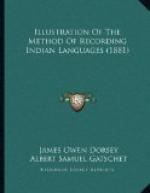Produced by Carlo Traverso, William Flis, and the Online Distributed Proofreading Team at http://www.pgdp.net
Transcriber’s note: The following symbols
are used to represent
special characters:
[n] = raised (superscript) “n”
[t] = turned (inverted) “t”
[k] = turned “k”
[K] = turned “K”
[T] = turned “T”
[k=] = “k” with inferior
macron
[k.] = “k” with inferior
dot
[=x] = any letter “x” with
superior macron
[)x] = any letter “x” with
superior breve
[x] = any letter “x” with
acute accent
[`x] = any letter “x” with
grave accent
[~x] = any letter “x” with
superior tilde
[^x] = any letter “x” with
superior circumflex
[:x] = any letter “x” with
superior diaeresis
[ng] = lower-case “eng” character
[x] = Greek letter chi
[c] = “c” with slash (cent
sign)
[’] = single (curly) closing quote
* * * * *
Smithsonian institution—Bureau of ethnology.
J.W. Powell, director.
* * * * *
ILLUSTRATION OF THE METHOD
OF
Recording Indian languages.
* * * * *
From the manuscripts of Messrs. J.O. Dorsey, A.S. Gatschet, and S.R. Riggs.
* * * * *
ILLUSTRATION OF THE METHOD OF RECORDING INDIAN LANGUAGES.
HOW THE RABBIT CAUGHT THE SUN IN A TRAP.
An Omaha myth, obtained from F. Lafleche by J. Owen Dorsey.
Egi[c]e|mactci[n]’ge|ak[/a]| i[k]a[n]’ |[c]i[n]k[e]|en[a]-qtci| It came| rabbit | the | his | the st. | only | to pass| | sub. |grandmother| ob. | |
|[t]ig[c]e|j[u]gig[c][a]-biam[a]. | dwelt | with his| they | | own,| say.
K[)i]|ha[n]’ega[n]tc[)e]’-qtci-hna[n]&rsquo
;|`[a]bae|ah[i]-biam[a].| And | morning very habit- | hunting| went thither | | ually | | they say. |
|Ha[n]ega[n]tc[)e]’-qtci|a[c][a]-bi | morning very|went, they | | say
ct[)e]wa[n]’|n[i]kaci[n]ga|wi[n]’|s[
i]|sned[)e]’-qti-hna[n]| notwith- | person | one | foot| long very as a | standing rule |
|s[i]g[c]e|a[c][a]-bit[e]am[a].|K[)i]|[ i>i]baha[n] 3 | trail | had gone, they say. | And | to know | him




